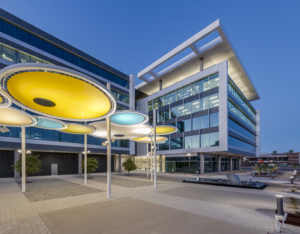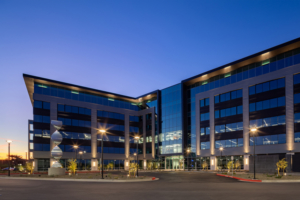Eco Buddies
This summer, two Phoenix office buildings entered new territory for existing private-sector buildings in Arizona. Collier Center and Phoenix Plaza became Arizona’s first privately owned multi-tenant existing buildings to receive the U.S. Green Building Council’s consideration for LEED certification, thanks to the efforts of their owners and their two building managers. Both buildings are seeking LEED-Existing Buildings: Operations & Maintenance (LEED-EB O&M) Silver-level certification.
Of course, LEED certification isn’t just about saving the world. It’s also about being best-in-class, separating a company’s building from its competition and improving operating efficiency. LEED-certified buildings promote an eco-friendly workplace and, in most cases, offer lower overall operating expenses — two factors tenants are specifically looking for these days.
LEED in the Private Sector
Yet, to date, the USGBC lists only three LEED-certified existing buildings in Arizona, two single-tenant quasi-government buildings and a single-tenant manufacturing facility. Arizona’s other LEED-certified buildings are new construction, and almost all are owned by the government.
So why aren’t more private-sector owners of existing buildings interested in LEED certification? Most either don’t know enough about the program or assume it’s too expensive. However, research entities like CB Richard Ellis are proving that LEED certification costs far less than believed, and can result in significant savings that will continue for the life of the asset.
For example, Collier Center reduced its electricity consumption by 30%, or 2.7 million kWh, between January 2009 and July 2009. Compared to the same time period in 2008, that’s a savings of $216,000, or 67 cents, PSF annualized — Phoenix Plaza’s results are equally as dramatic.
Also, Collier Center and Camelback Esplanade III are transitioning janitorial services to daytime cleaning, and anticipate reductions in annual lighting costs of 10 cents to 15 cents PSF.
The Cost of Green
Minimum costs to pursue LEED certification include a small registration fee of about $500 and a certification fee, which depends on a building’s size. As property manager for both Collier Center and Phoenix Plaza, CBRE reports these costs at $12,500 for each building. Additional costs to satisfy prerequisites and credits vary from building to building. Of the 30 applications CBRE’s Sustainability Programs group has completed so far, the costs to certify averaged 24 cents PSF, and ranged from 10 cents to 67 cents PSF.
For CBRE, the certification projects took approximately 6 months to complete, including determining each building’s existing status and satisfying certification requirements in 6 categories under LEED-EB O&M:
- sustainable sites
- water efficiency
- energy and atmosphere
- materials and resources
- indoor environmental quality
- innovation in operation
- and upgrades
Overwhelmingly, the process has been favorably received by existing tenants — and many have even begun seeking ways to improve on their own green efforts.
A broad implementation of sustainability practices, such as LEED, in the nation’s private-sector existing buildings can significantly advance progress toward energy independence and precious resource conservation, while also promoting eco-friendly workplace environments and cutting operating costs.
[stextbox id=”grey”]
[/stextbox]



